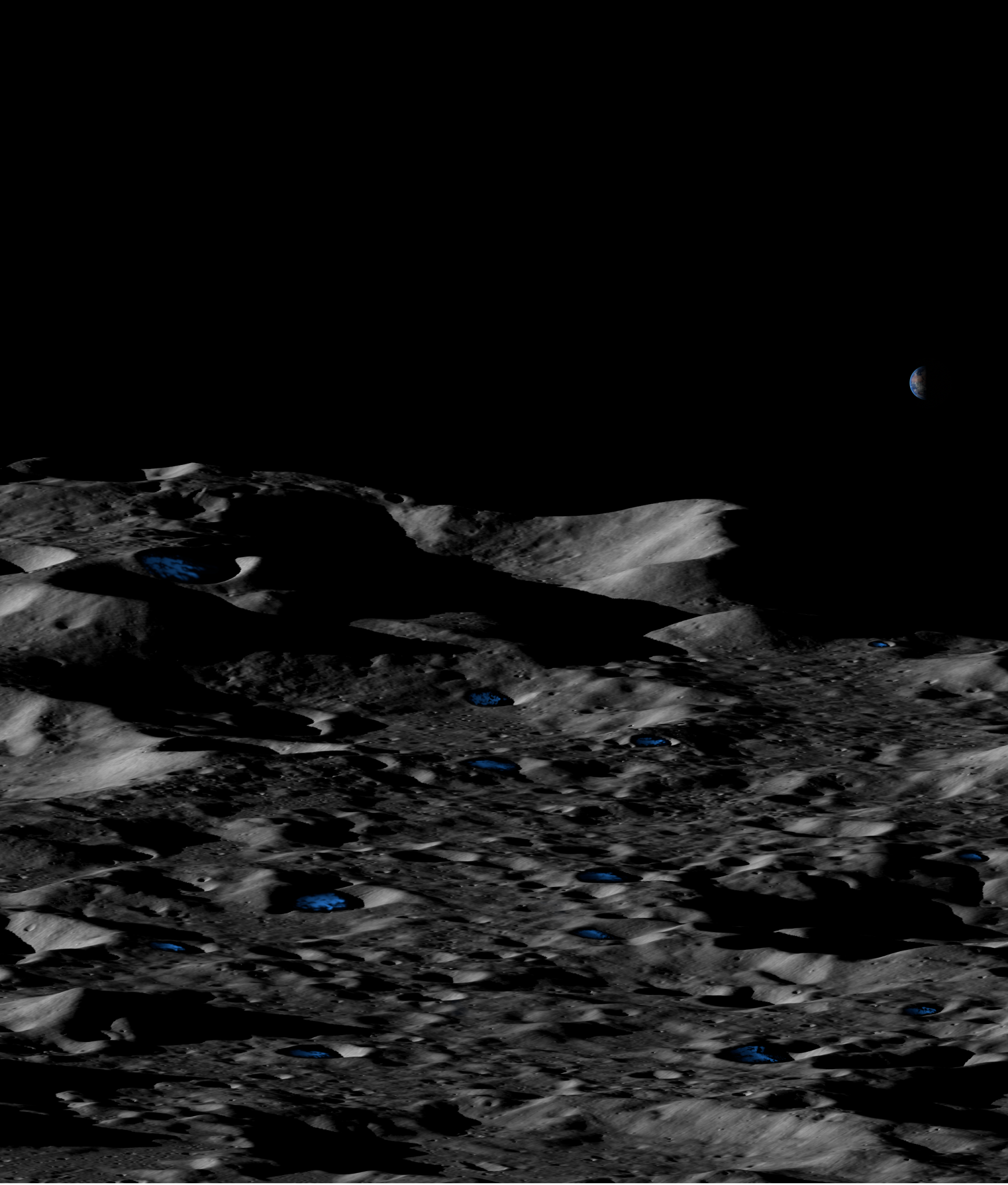Earth’s Moon and Mercury, the closest planet to the Sun, may contain significantly more water ice than previously thought, according to a new analysis of data from NASA’s LRO and MESSENGER spacecraft.
The potential ice deposits are found in craters near the poles of both worlds. On the Moon, “We found shallow craters tend to be located in areas where surface ice was previously detected near the south pole of the Moon, and inferred this shallowing is most likely due to the presence of buried thick ice deposits,” said lead author Lior Rubanenko of the University of California, Los Angeles.
In the past, telescopic observations and orbiting spacecraft have found glacier-like ice deposits on Mercury, but as of yet not on the Moon. The new work raises the possibility that thick ice-rich deposits also exist on the Moon. The research may not only help resolve the question regarding the Moon’s apparent low ice abundance relative to Mercury, but it could also have practical applications: “If confirmed, this potential reservoir of frozen water on the Moon may be sufficiently massive to sustain long-term lunar exploration,” said Noah Petro, Lunar Reconnaissance Orbiter Project Scientist at NASA’s Goddard Space Flight Center in Greenbelt, Maryland.
The poles of Mercury and the Moon are among the coldest places in our solar system. Unlike Earth, the spin axes of Mercury and the Moon are oriented such that, in their polar regions, the Sun never rises high above the horizon. Consequently, polar topographic depressions, such as impact craters, never see the Sun. For decades it has been postulated these so-called permanently shadowed regions are so cold that any ice trapped within them can potentially survive for billions of years.
Previous observations of the poles of Mercury with Earth-based radar revealed a signature characteristic of thick, pure ice deposits. Later, MESSENGER – the MErcury Surface, Space ENvironment, GEochemistry and Ranging spacecraft – imaged these ice deposits. “We showed Mercury’s polar deposits to be dominantly composed of water ice and extensively distributed in both Mercury’s north and south polar regions,” said Nancy Chabot, instrument scientist for MESSENGER’s Mercury Dual Imaging System from the Johns Hopkins Applied Physics Laboratory in Laurel, Maryland. “Mercury’s ice deposits appear to be much less patchy than those on the Moon, and relatively fresh, perhaps emplaced or refreshed within the last tens of millions of years.”
Previous radar and imaging studies of the Moon, whose polar thermal environments are very similar to those of Mercury, found only patchy, shallow ice deposits. This outstanding difference served as the motivation for the UCLA researchers’ work – a comparative analysis of polar craters on Mercury and the Moon to delve into this difference between the two worlds. The research was published July 22 in Nature Geoscience.
The airless surfaces of Mercury and the Moon are scarred by many impact craters. These craters form when meteoroids or comets impact the surface. The team analyzed simple craters that are formed by smaller, less energetic impactors. These depressions are held together by the strength of the surface dust layer, or regolith and tend to be more circular and symmetrical than large craters. The UCLA scientists exploited this inherent symmetry to estimate the thickness of ice trapped within simple craters.
The study used elevation data obtained by MESSENGER and LRO to measure approximately 15,000 simple craters with diameters ranging from 2.5 km to 15 km (about 1.5 miles to 9.3 miles) on Mercury and the Moon. Researchers found that craters become up to 10% shallower near the north pole of Mercury and the south pole of the Moon, but not the north pole of the Moon.
The authors concluded that the most probable explanation for these shallower craters is the accumulation of previously undetected thick ice deposits on both worlds. Supporting this conclusion, the researchers found that the pole-facing slopes of these craters are slightly shallower than their equator-facing slopes, and that the shallowing is more significant in regions that promote ice stability because of Mercury’s orbit around the Sun. The topographic signal detected by the scientists is relatively more prominent in smaller simple craters, but does not preclude the possibility that ice may be more widespread in larger craters across the lunar pole.
Additionally, unlike Mercury, where the ice has been shown to be nearly pure, the deposits detected on the Moon are most likely mixed with the regolith, possibly in a layered formation. The typical age of the simple craters examined by the researchers indicates they could potentially accumulate ice that was later mixed with overlying regolith over long time scales. The scientists found that these inferred buried ice deposits are correlated with the locations of already detected surface ice. This finding could imply that the exposed ice deposits may be exhumed, or they could result from molecular diffusion from depth.
The research was funded by the LRO and MESSENGER missions. LRO is managed by NASA’s Goddard Space Flight Center in Greenbelt, Maryland, for the Science Mission Directorate at NASA Headquarters in Washington. Launched on June 18, 2009, LRO has collected a treasure trove of data with its seven powerful instruments, making an invaluable contribution to our knowledge about the Moon. MESSENGER was managed by the Johns Hopkins University Applied Physics Laboratory. The spacecraft was launched Aug 3, 2004, and began orbiting Mercury on March 18, 2011. The mission ended with a planned impact on the surface of Mercury on April 30, 2015. NASA is leading a sustainable return to the Moon with commercial and international partners to expand human presence in space and bring back new knowledge and opportunities.
Bill Steigerwald / Nancy Jones
NASA’s Goddard Space Flight Center, Greenbelt, Md.


























